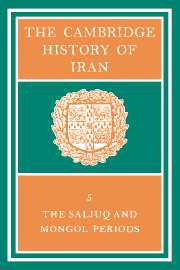Book contents
- Frontmatter
- 1 THE POLITICAL AND DYNASTIC HISTORY OF THE IRANIAN WORLD (A.D. 1000–1217)
- 2 THE INTERNAL STRUCTURE OF THE SALJUQ EMPIRE
- 3 RELIGION IN THE SALJUQ PERIOD
- 4 DYNASTIC AND POLITICAL HISTORY OF THE IL-KHĀNS
- 5 THE ISMĀ‘ĪLĪ STATE
- 6 THE SOCIO-ECONOMIC CONDITION OF IRAN UNDER THE ĪL-KHĀNS
- 7 RELIGION UNDER THE MONGOLS
- 8 POETS AND PROSE WRITERS OF THE LATE SALJUQ AND MONGOL PERIODS
- 9 THE VISUAL ARTS, 1050–1350
- 10 THE EXACT SCIENCES IN IRAN UNDER THE SALJUQS AND MONGOLS
- Bibliography
- Index
- Plate section
- References
7 - RELIGION UNDER THE MONGOLS
Published online by Cambridge University Press: 28 March 2008
- Frontmatter
- 1 THE POLITICAL AND DYNASTIC HISTORY OF THE IRANIAN WORLD (A.D. 1000–1217)
- 2 THE INTERNAL STRUCTURE OF THE SALJUQ EMPIRE
- 3 RELIGION IN THE SALJUQ PERIOD
- 4 DYNASTIC AND POLITICAL HISTORY OF THE IL-KHĀNS
- 5 THE ISMĀ‘ĪLĪ STATE
- 6 THE SOCIO-ECONOMIC CONDITION OF IRAN UNDER THE ĪL-KHĀNS
- 7 RELIGION UNDER THE MONGOLS
- 8 POETS AND PROSE WRITERS OF THE LATE SALJUQ AND MONGOL PERIODS
- 9 THE VISUAL ARTS, 1050–1350
- 10 THE EXACT SCIENCES IN IRAN UNDER THE SALJUQS AND MONGOLS
- Bibliography
- Index
- Plate section
- References
Summary
As we have already seen, at the time of the Mongol conquest most of Iran was Sunnī; indeed, says Molé, this was “one of the most Islamked countries in the Middle and Near East”. Small Zoroastrian minorities existed in one or two centres, but played only a secondary role in the country's religious life. There were also Jews and Christians, but the latter were far less numerous than in the Arabic-speaking countries of Syria, Egypt, and Iraq. A summary of the distribution of the various Muslim schools and sects in Iranian territory has been given above, pp. 283–302.
The Mongol invasion of Persia, which began in 1220, together with the subsequent fall of the Baghdad caliphate (1258) and the killing of the last ‘Abbasid caliph, al-Musta‘Ṣim billāh, brought the entire Muslim world and especially Persia face to face with unexpected and formidable problems. For the first time in the history of Islam a great part of the Muslim world found itself under the rule of a non-Muslim power—and not only non-Muslim, but one which, to begin with, was in general anti-Muslim. At the same time, however, when the Mongols destroyed the external and political power of the reformed Ismā‘īlism of Alamūt, they thus saved orthodox Islam from the continual menace which it represented. And their destruction of the Sunnī caliphate in Baghdad meant that for the first time Sunnism was deprived of every semblance of political authority, and this could only be an advantage for Shī‘sm. The presence of a Shī‘ī theologian, and one of the greatest of the time, among Hülegü's advisers was, to say the least, significant.
- Type
- Chapter
- Information
- The Cambridge History of Iran , pp. 538 - 549Publisher: Cambridge University PressPrint publication year: 1968
References
- 15
- Cited by

